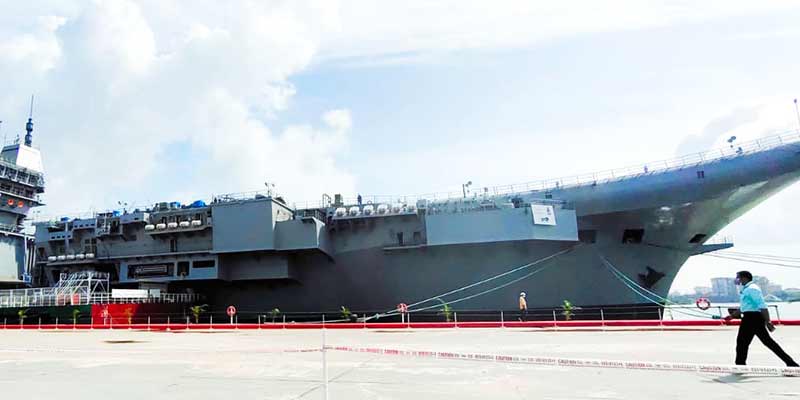- India
- Jun 26
India’s first Indigenous Aircraft Carrier will be commissioned next year
India’s first Indigenous Aircraft Carrier (IAC) will be commissioned next year and its combat capability, reach and versatility will add formidable capabilities in the country’s defence, Defence Minister Rajnath Singh said.
The minister reviewed the progress in construction of IAC in the Cochin port.
He was briefed about the successful Basin Trials completed during November 2020. He was also apprised of the progress achieved on integration of a number of other navigational, communication and operational systems since then, as it prepares for its maiden Contractor Sea Trials (CST) which is expected in the forthcoming months.
He said the IAC boasts of nearly 75 per cent indigenous content, from design, to steel used in construction, to key weapons and sensors.
Aircraft carriers in India
An aircraft carrier is a warship designed to support and operate aircraft, engaged in attacks on targets afloat or ashore and to undertake sustained operations in support of other forces. An aircraft carrier is central to the operational requirements and fleet doctrine of the Indian Navy and is the only means of ensuring air defence of sea.
INS Vikrant, India’s first aircraft carrier was acquired from Great Britain and commissioned on March 4, 1961. INS Vikrant was a Majestic class CATOBAR (Catapult Assisted Take Off but Arrested Recovery) carrier and operated Sea Hawk fighters, Alize (Anti-Submarine Warfare) aircraft and Seaking helicopters.
India next acquired HMS Hermes, a Centaur class STOVL (Short Take-off and Vertical Landing) carrier and a veteran of the Falkland War. INS Viraat was commissioned on May 12, 1987 as India’s second aircraft carrier and India’s first STOVL carrier operating the Sea Harrier aircraft.
Soon after the acquisition of INS Viraat, INS Vikrant was also converted from a CATOBAR carrier to a STOVL carrier.
INS Vikramaditya was commissioned on November 16, 2013. INS Vikramaditya is a Kiev class aircraft carrier which was commissioned by Russian Navy in 1987 under the name Baku. It was later renamed as Admiral Gorshkov and last sailed in 1995 in Russia, before being offered to India. The 44,500 tonne warship has a length of 284 metres.
INS Vikrant was decommissioned in January 1997.
INS Viraat was decommissioned in 2017.
At present, India has only one aircraft carrier — INS Vikramaditya.
Indigenous Aircraft Carrier
The IAC would be commissioned as INS Vikrant in the first half of 2022.
It shall carry MiG-29K fighter aircraft, Kamov-31 Air Early Warning Helicopters, the soon to be inducted MH-60R multi-role helicopter and the indigenously manufactured Advanced Light Helicopters.
It would offer an incomparable military instrument with its ability to project Air Power over long distances, including Air Interdiction, Anti-Surface Warfare, offensive and defensive Counter-Air, Airborne Anti-Submarine Warfare and Airborne Early Warning.
Project Seabird
On June 24, Rajnath Singh visited the Karwar Naval Base and reviewed the progress of ongoing infrastructure development under ‘Project Seabird’.
In the early 1980s, then Chief of the Naval Staff Admiral Oscar Stanley Dawson conceived of a dedicated naval base near Karwar in Karnataka.
In 1999, the then Defence Minister George Fernandes approved ‘Project Seabird’ to pursue the construction of the new naval base at Karwar.
Over 5 km of breakwater were constructed using over 44 lakh cubic meters of rock to protect the harbour.
Spread over an area of 45 sq km and 23 km of coastline on the Arabian Sea, phase 1 of the base — INS Kadamba — was commissioned in May 2005.
Naval Ship Repair Yard (Karwar) has been set up as a repair and refit organisation, as part of phase 1 of ‘Project Seabird’. The Yard opened operations in July 2006 and the shiplift was commissioned in November 2006.
Development of phase 2 of INS Kadamba commenced in 2011.
Rajnath Singh has said that it will be the largest naval base of the Indian Navy in future, and will provide the facilities and infrastructure to support the Navy’s operations in the Indian Ocean Region and beyond.
Manorama Yearbook app is now available on Google Play Store and iOS App Store


